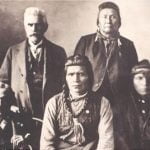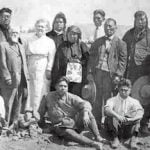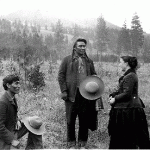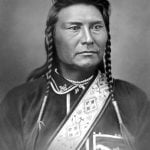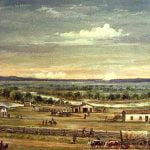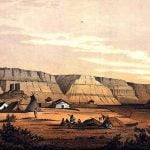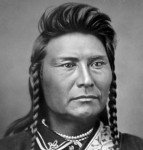
Chief Joseph. Hinmaton-yalatkit. The leader of the Nez Percé in the hostilities of 1877. His mother was a Nez Percé, his father Tuekakas, a Cayuse, who received the name Joseph from his teacher, the missionary Spalding, who was with Dr. A. Whitman and who went to the Idaho country in the late thirties of the 19th century. Chief Joseph’s native name was Hinmaton-yalatkit (Hinmaton, `thunder’; yalatkit, ‘coming from the water up over the land.’ – Miss McBeth), but both he and his brother Ollicot were often called Joseph, as if it were a family name. Joseph was a man of fine presence and impressive features, and was one of the most remarkable Indians within the borders of the Union.
The treaty of 1863, by which the whites obtained a right to the Wallowa valley, the ancient home of Joseph’s band in North East Oregon, was not recognized by Joseph and the Indians sympathizing with him, who continued to dwell there in spite of collisions between the Indians and the whites, which became more and more frequent.
The matter of removing these Indians to the Lapwai Reservation in Idaho, after the failure of a commission the previous year, was proceeding to a peaceful settlement when outrageous acts on the part of the white settlers caused the Nez Percé to break loose and attack the settlements. A war was declared after several engagements, in which the whites lost severely, Joseph displayed remarkable generalship in a retreat worthy to be remembered with that of Xenophon’s ten thousand 1. In spite of the fact that in front of him was Col. Miles, behind Gen. Howard, on his flank Col. Sturgis and his Indian scouts, Joseph brought his little band, incommoded with women and children, to within 50 miles of the Canadian border, their objective point, when they were cut off by fresh troops in front an forced to surrender conditionally on Oct. 5, 1877. Not only the conduct of the Nez Percé during this retreat of more than 1,000 miles, but also the military and tactical skill displayed by their leader, won unstinted praise from their conquerors. The promises made to Joseph and his people were ignored and the removed to Ft Leavenworth, Kansas, and afterward to Indian Territory, where they remained for several years, always yearning for the mountains and valleys of Idaho. In 1883 a party of 33 women and children were allowed to go back to their old home, and were followed the next year by 118 others. Joseph and the remaining members of his band, however, numbering 150, were not permitted to return to Idaho, but were sent to the Colville Reservation, Washington. He lived to visit President Roosevelt and General Miles at Washington in March, 1903, but died at Nespelim, on the Colville Reservation, Washington, September 21, 1904.
According to the Indian agent he had become reconciled to civilization in his last years, lending his aid in the education of the children of his tribe, and discouraging gambling and drunkenness.
Further Information on Chief Joseph
- The Great War Chief Joseph of the Nez Perces, and his lieutenants, White Bird and Looking-Glass
- Pacific Northwest Indian Wars
The last of the Indian wars of the Pacific Northwest was fought barely three-quarters of a century ago. People still living have childhood recollections of those perilous days. Those wars have been adequately recorded, either separately or geographically by States as well as in the general histories. However, no one has heretofore compiled the story of all of them into a single history. The period from the early 1840's to 1879 was filled with danger and death from the warring tribes and is replete with the struggles incident to the settlement of new territory. Blame for hostilities did not always rest with the Indians. These struggles brought out the best and the worst traits in men, white and Indian alike. Their history is sometimes poignant, sometimes tragic, and occasionally humorous.
Citations:


